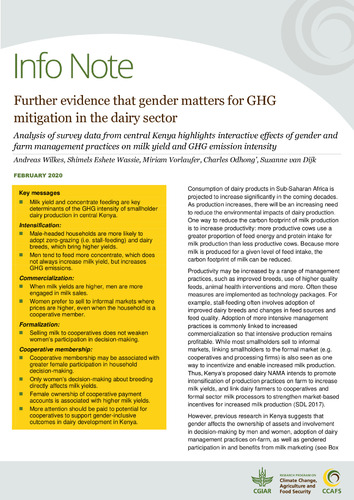Further evidence that gender matters for GHG mitigation in the dairy sector: Analysis of survey data from central Kenya highlights interactive effects of gender and farm management practices on milk yield and GHG emission intensity
Abstract
Consumption of dairy products in Sub-Saharan Africa is projected to increase significantly in the coming decades. As production increases, there will be an increasing need to reduce the environmental impacts of dairy production. One way to reduce the carbon footprint of milk production is to increase productivity: more productive cows use a greater proportion of feed energy and protein intake for milk production than less productive cows. Because more milk is produced for a given level of feed intake, the
carbon footprint of milk can be reduced. Productivity may be increased by a range of management practices, such as improved breeds, use of higher quality feeds, animal health interventions and more. Often these measures are implemented as technology packages. For example, stall-feeding often involves adoption of improved dairy breeds and changes in feed sources and
feed quality. Adoption of more intensive management practices is commonly linked to increased commercialization so that intensive production remains profitable. While most smallholders sell to informal markets, linking smallholders to the formal market (e.g. cooperatives and processing firms) is also seen as one way to incentivize and enable increased milk production.
Thus, Kenya’s proposed dairy NAMA intends to promote intensification of production practices on farm to increase milk yields, and link dairy farmers to cooperatives and formal sector milk processors to strengthen market-based incentives for increased milk production (SDL 2017).

